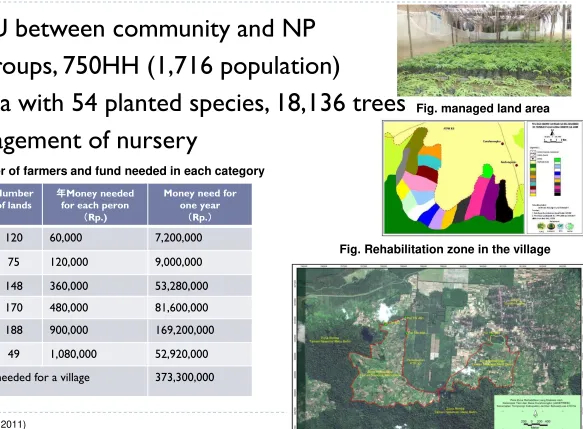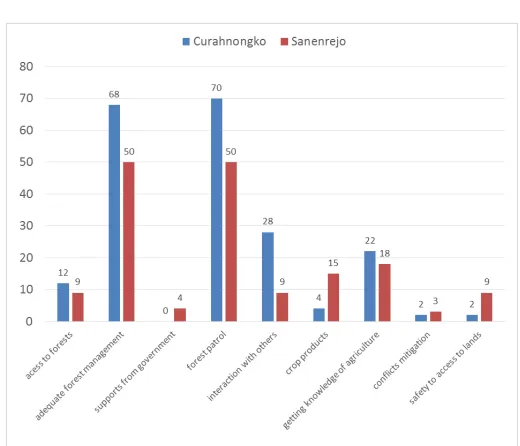Linking community forestry and national park for conserving forests and improving local livelihoods
in South and Southeast Asia
Kazuhiro HARADA
Graduate School of Bioagricultural Sciences, Nagoya University
12, Oct, 2018 Yogyakarta
International conference on
Relationships of local people
with tropical forests
Why local people?
Approximately 500 million forest-dependent people
Daily use of forest resource for fuel woods, building materials, medicines, food, agroforestry
Position of Local people
Occupation of state-owed land
Conflict associated with landownership, land and forest use
Land tenure in South and Southeast
Asian countries
Mostly state owned forest
Unstable rights and livelihoods under the state forests
Participation in CF
Use of unrecognized customary forest in state forests
Table Forest area and land ownership in South and Southeast
Asia
Cambodia Indonesia Phippines India Nepal Vietnam Thailand Malaysia Land area(1,000ha) 17,652 181,157 29,817 297,319 14,330 31,008 51,089 32,855 Primary forest area(
1,000ha) 10,094 (322)
private 12% state 98 % few individual and
communitie
Conflicts between government and communities
in national parks in Indonesia
Customary use of natural resources in NPs
Customary use of natural resources
Cultivating gardens etc.
Oil palm plantation in NPs
Expanding of oil palm plantation
Conflict between local people and wild animals
Coffee plantation in NPs
Existence of coffee plantation in NPs
Exporting coffee
Innovative participatory FM
REDD+ in UNFCCC
Certification as private governance
Recognition of customary forests
,
Innovative participatory forest management
conventional community forestry
“Illegal” forest use by local people in national parks and customary forests
before 1990s
after 2000s
Triple-benefit
Biodiversity conservation
Climate change mitigation
Our research project funded
by Japanese government (JSPS)
Title: Community Forestry in New Era of encouraging local livelihoods under international climate change and forest conservation policies
Fund: Japanese government (JSPS)
Period: 2015-2018 (by the end of March, 2019)
Purpose: To make clear social and economic conditions that CF, which has
been led by each country’s initiatives, may ensure local livelihoods to be
more stable and sustainable while local people can take initiatives under international climate change and forest conservation policies
Categorizing CF
1) CF under national government-oriented forest policies
2) CF under national people-oriented forest policies
3) CF associated with international climate change and forest conservation policies
4) CF associated with international voluntary institutions
Targeted countries
CF in and around national parks
in South and Southeast Asia
CF inside a national park in Bhutan- Jigme Dorji NP
CF in buffer zone of a national park in Nepal- Chitwan NP
History of Community Forestry in Bhutan
Before 1960s:All forests were state forest and people were allowed to access to forest resources
1969:Forests were regularly owned by state. People needed to get permission of utilizing forest resources from
government with paying royalty.
1960s:Local participation was encouraged for forest
management.
1979:CF was introduced by Royal Decree (Chheteri et al., 2009)
1990s:Local participation was recognized for forest conservation and CF was disseminated.
Government system of CF
CF’s position
Government Reserve Forest
Protected Areas
CF
’ regulations
1969:Forest Act
1995:Forest and Nature Conservation Act
2006:Forest and Nature Conservation Rules and Regulations
2010:National Strategy for Community Forestry: The Way Ahead
2017: Forest and Nature Conservation Rules and Regulations
Department of Forests and Park Services
Forest Protection
National Park and local people in Bhutan
General situations of NPs in Bhutan
10 PAs(4 NPs, 43% of total forest areas)
Local people dwelling, cultivating and using FRs
Existing CF inside
Jjgme Dorji National Park
Located in Western part
1974:Wildlife Sanctuary
1993:NP
Area is 431,600ha
Population is 6,000
Processes for getting CF
Establishing FMG (At least 5 people)
Preparing Management Plan support by
forest rangers
Submitting and evaluating MP
Getting CF certification (valid for 10yrs)
Extending 10 yrs later
Obligations of CF members
Admission fee
(
50N
)、
Annual fee
(
200N
)
,
(1N=about1.7 yen, 1yen=about Rp.135)
Participation of people in varieties of activities, such
as
Inventory for forest management plan Plantation activities based on annual plan
maintenance of boarders
weeding
pruning and thinning
Those who did not participate need to
pay penalty
Forest resources from CF
Timber wood
constructing wood
Non-timber wood
fuelwood pole fence
Agricultural tools ・・・
NTFP
mainspring
mushroom
Forest royalty of extracting timber and
obligation after extracting timber in CF
Category of timber thickness
Drashing (>40cm):40N/piece
Cham (30-40cm): 30N /piece 1N=about 1.7yen Tsim (20-30cm): 12N /piece
Dong Chung(10-20cm): 4N /pirce
Building construction:
all category of timber
fuelwood:
Drashing
Obligation after extracting timber (Drashing and
Cham)
CF management plan for JDNP
Sustainable forest management
Annual allowable cut
Penalty for violation
Illegal logging, grazing, hunting, absence of meeting
Activities regulations
Gathering fuelwood
Prohibition of cutting on slopes Gathering only dead and fallen trees Prohibition of cutting in water resources
Extracting building materials
Prohibition of cutting on slopes
Prohibition of cutting in water resources Prohibition of cutting beyond allowed amount
Process for extracting timber:
From permission to marking
(Building construction, fuelwood, pole, fence)
GRF
Local people→Sub-district→range office finally to the central government
Local people are accompanied by rangers
for marking
CF
Getting permission from the CF chairman
→the head of CF applying to range office →Local people are accompanied
Protected Areas and National Parks
in Nepal
20 PAs (Nepal:34,898 km2 (23.63% ), 11 national parks
Buffer Zone was introduced to reconcile both
conservation goal and locally sustainable development needs (Heinen and Mehta 2000)
Started ecotourism and introduced strict forest rules
Access to the forest resources narrowed down
546 Buffer Zone Community Forest (BZCF), 94,626 HH,
including PAs and NPs
Chitwan National Park in Nepal
Firstly established NP in Nepal in 1973 Total area 932 km2
Access to NP by local people prohibited
Surrounded by buffer zone with total area 750km2, established in 1996
Buffer zone’s role
conserve forests in NP
by mitigating human impacts
Improve local livelihoods expand community forest
local use of natural resources
encourage ecotourism
Local use of forest and forest resource in BZ
Grazing Fodder
Fuelwood
Entrance permit
Fern (Dryopteris cochleata)
Stinging nettle (Urtica dioca)
Forest resources extraction rules in BZ
Ecotourism activities in BZ
Increased revenue for government
90% of total income is from ecotourism
Distributed income for communities
30-50% of total ecotourism income for communities
NOT for individuals
Communities development
Conservation awareness
Jeep Safari
Income generation Road and Fence
Homestay
Negative impacts of strict rules of BZ
Grazing lands in BZ are strictly managed.
Only some designated areas were allowed for local use for fodder.
Decrease of livestock because of the lack of fodder
Less use of biogas, using cow dung
more dependency on fuel wood for cooking
Negative impacts of strict rules of BZ
Change of vegetation from grazing land to bushland
Connection of forests from NP to settlements via BZ
community forest
Human-wildlife conflicts
dead 9
Injured 19
livestock damage 66
house damage 41
food stock 3
agricultural products 77
(July, 2014- June, 2015)
Grazing land
Emergence of wild animal into the village
Buffer zone Human Settlement National Park
Bush land
National parks in Indonesia
Basically local people are not allowed to settle down and
do some activities in NPs
Some projects such as collaborative forest management
and REDD+ related activities are implemented in use zone of NPs
9 Sungai Sembilang
10 Bukit Barisan Selatan
11 Way Kambas
12 Ujung Kulon
13 Gunung Halimun
14 Gunung Gede Pangrango
15 Gunung Ciremai
16 Gunung Merbabu
17 Gunung Merapi
18 Bromo Tengger Semeru
19 Baluran
20 Meru Betiri
21 Alas Purwo
22 Bali Barat
23 Tanjung Putting
24 Sebangau
25 Kutai
26 Kayan Mentarang
27 Gunung Palung
28 Danau Sentarum
29 Betung Karihun
30 Bukit Baka-Bukit Raya
31 Gunung Rinjani
32 Manupeu-Tanah Daru
33 Laiwangi-Wanggameti
34 Kelimutu
35 Bogani Nani wartabone
36 Lore Lindu
37 Rawa Aopa Watumohai
38 Bantimurung-Bulusarawung
39 Aketajawe-Lolobata
40 Manusela
41 Lorentz
42 Wasur 注)海洋国立公園は 除く
Meru Betiri National Park
Outline of NP
Established in 1997, total area 58,000ha
12villages, approximately 130,000 people living surrounding NP
Paddy fields and agricultural lands
From illegal logging to collaborative forest management within NP
Illegal cut of teak (4,000ha) inside NP in 1998
Plantation and agroforestry in the site of teak forests
REDD+ project started in 2010
Outline of REDD+ project
Organization involved: NP office, LATIN, ITTO,
FORDA
Period: 2010-2013
Target area: Rehabilitation zone, 4,000ha
Fund: Seven& I holding Japan, ITTO, MoF
Project activities:
Participatory patrol and forest management
Agroforestry of REDD+ project in NP
Category Density
(trees/ha)
Plantation activities through agroforestry
in a village
MOU between community and NP
17 groups, 750HH (1,716 population)
410ha with 54 planted species, 18,136 trees
Management of nursery
Fig. Rehabilitation zone in the village Fig. managed land area
Category Number of lands
年Money needed for each peron
(Rp.)
Money need for one year Total money needed for a village 373,300,000
LATIN (2012, 2011)
Motivation and income of participants
from plantation program in a village
High proportion of participants’
income from activities such as selling agricultural products in the national park, which is
approximately 25-40%
Giving opportunities for
non-participants to get jobs and income for supporting others
Towards promotion of community-based
sustainable forest management
CF still important components to consider maintenance
of local livelihood under international climate change and forest conservation policies
extract timber and NTFPs
getting social services
Recently, more clearly identified local rights, but still weakness and need to strengthen more
More focused on local livelihoods under the concept of
SDGs
poverty reduction
conserve forest



